Related Research Articles
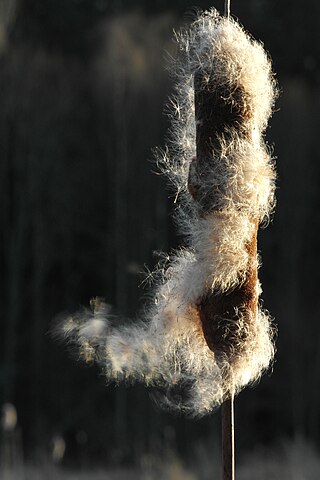
Typha is a genus of about 30 species of monocotyledonous flowering plants in the family Typhaceae. These plants have a variety of common names, in British English as bulrush or reedmace, in American English as reed, cattail, or punks, in Australia as cumbungi or bulrush, in Canada as bulrush or cattail, and in New Zealand as reed, cattail, bulrush or raupo. Other taxa of plants may be known as bulrush, including some sedges in Scirpus and related genera.

Mer Bleue Bog is a 33.43 km2 (12.91 sq mi) protected area in Gloucester, Ontario, an eastern suburb of Ottawa in Eastern Ontario, Canada. Its main feature is a sphagnum bog that is situated in an ancient channel of the Ottawa River and is a remarkable boreal-like ecosystem normally not found this far south. Stunted black spruce, tamarack, bog rosemary, blueberry, and cottongrass are some of the unusual species that have adapted to the acidic waters of the bog.
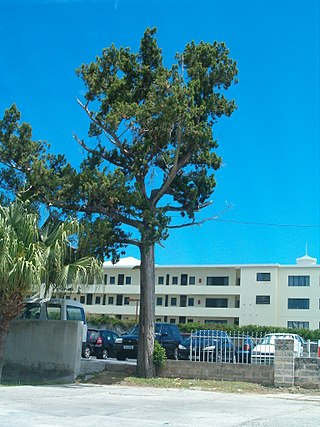
The flora and fauna of Bermuda form part of a unique ecosystem due to Bermuda's isolation from the mainland of North America. The wide range of endemic species and the islands form a distinct ecoregion, the Bermuda subtropical conifer forests.
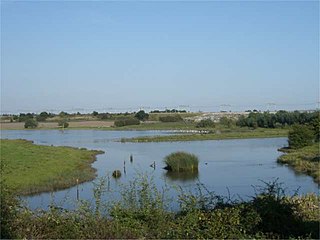
Sandbach Flashes are a group of 14 wetlands west of Sandbach in Cheshire, England. The flashes were designated as a Site of Special Scientific Interest in 1963, with a total area of 1.53 km2. There are a number of individual flashes including Bottom's Flash, Crabmill Flash, Elton Hall Flash, Fodens Flash, Groby's Flash, Ilse Pool, Moston Flashes, Pump House Flash, Railway Flash, Red Lane Tip and Pool, and Watch Lane Flash.
This article gives an overview of the swamp and tall-herb fen communities in the British National Vegetation Classification system.

The Lee and Virginia Graver Arboretum is an arboretum owned by Muhlenberg College and located at 1581 Bushkill Center Road in Bath, Pennsylvania. The arboretum is open daily without charge.

Eleocharis is a virtually cosmopolitan genus of 250 or more species of flowering plants in the sedge family, Cyperaceae. The name is derived from the Greek words ἕλειος (heleios), meaning "marsh dweller," and χάρις (charis), meaning "grace." Members of the genus are known commonly as spikerushes or spikesedges. The genus has a geographically cosmopolitan distribution, with centers of diversity in the Amazon Rainforest and adjacent eastern slopes of the South American Andes, northern Australia, eastern North America, California, Southern Africa, and subtropical Asia. The vast majority of Eleocharis species grow in aquatic or mesic habitats from sea level to higher than 5,000 meters in elevation.

Eleocharis palustris, the common spike-rush, creeping spike-rush or marsh spike-rush, is a species of mat-forming perennial flowering plants in the sedge family Cyperaceae. It grows in wetlands in Europe, North Africa, northern and central Asia and North America. Eleocharis palustris is not easily distinguished from other closely related species and is extremely variable worldwide itself. The species epithet palustris is Latin for "of the marsh" and indicates its common habitat.
Palustris is a Latin word meaning "swampy" or "marshy", and may refer to:
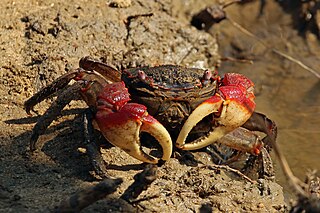
The Southern Africa mangroves are mangrove ecoregion on the Mozambique's southernmost coast and the eastern coast of South Africa.

The Sunda Shelf mangroves ecoregion, in the mangrove biome, are on the coasts of the islands of Borneo and eastern Sumatra in Malaysia and Indonesia. They are home to the proboscis monkey.

Scirpus ancistrochaetus is a rare species of flowering plant in the sedge family known by the common names barbedbristle bulrush and northeastern bulrush. It is native to the northeastern United States from New Hampshire south to Virginia. It used to be found in Quebec but it is now thought to be extirpated there. It was also believed extirpated from the state of New York, but at least one population has been rediscovered in Steuben County in 2010. It is threatened by the loss and degradation of its wetland habitat. It is a federally listed endangered species.

Rhizophora mucronata is a species of mangrove found on coasts and river banks in East Africa and the Indo-Pacific region.
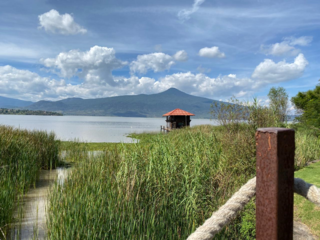
The Central Mexican wetlands is a flooded grasslands and savannas ecoregion in central Mexico.

The Moist Pacific Coast mangroves ecoregion covers a series of disconnected mangrove sites along the Pacific Ocean coast of Costa Rica and Panama. These sites occur mostly on coastal flatlands around lagoons, particularly where rivers from the inland mountains reach the sea, bringing fresh water to the coastal forests. The area is in a transition zone from the drier coastline to the north; rainfall in this ecoregions is over 2,000 mm/year, and reaches over 3,600 mm/year at the southern end.
References
- ↑ Bunthoeurn, Orm. "Tonle Sap Authority discovers 196 new plants around Tonle Sap Lake, one special species".
- ↑ "Sundarban Tiger Reserve- Flora". sundarbantigerreserve.org.
- ↑ Choi, Jaein; Lee, Sangdon (2022). "Principal bioclimatic variables of ten dominant plant species in Korea wetland using the Maxent model". Ecological Engineering. 183. Bibcode:2022EcEng.18306729C. doi:10.1016/j.ecoleng.2022.106729. S2CID 251331922.
- ↑ "OKAVANGO DELTA". www.botswana-info.com.
- ↑ "Lake Chad". World Lake Database.
- ↑ Ramberg, Lars; Hancock, Peter; Lindholm, Markus; Meyer, Thoralf (2006). "Species diversity of the Okavango Delta, Botswana". Aquatic Sciences. 68 (3): 310. Bibcode:2006AqSci..68..310R. doi:10.1007/s00027-006-0857-y. S2CID 46199558.
- ↑ Van Biljon, Georgina (2023). "The power of palmiet". Veld & Flora.
- ↑ Rongoei, P.J.K.; Kipkemboi, J.; Kariuki, S.T.; van Dam, A.A. (2014). "Effects of water depth and livelihood activities on plant species composition and diversity in Nyando floodplain wetland, Kenya". Wetlands Ecology and Management. 22 (2): 177–189. Bibcode:2014WetEM..22..177R. doi:10.1007/s11273-013-9313-7. S2CID 255103381.
- ↑ Bennion, Jenny (7 December 2022). "What is sphagnum moss and why is it important?". The Wildlife Trust for Lancashire, Manchester and North Merseyside.
- ↑ "COMMON WETLAND PLANTS OF OHIO" (PDF). Ohio Natural Areas and Preserves.
- ↑ Oliveira, Lukiel dos Santos; Andrade, Bianca Ott; Boldrini, Ilse Iob (2019). "Aquatic vascular plants of South Brazil: checklist and a comparative floristic approach". Acta. Bot. Bras. 33 (4): 709–715. doi:10.1590/0102-33062019abb0194. hdl: 10183/221500 .
- ↑ Schipper, Jan. "Pantanal". One Earth.
- ↑ Gonzalez, Eliana; Trilla, Gabriela Gonzalez; San Martin, Laura; Grimson, Rafael; Kandus, Patricia (2019). "Vegetation patterns in a South American coastal wetland using high-resolution imagery". Journal of Maps. 15 (2): 642–650. Bibcode:2019JMaps..15..642G. doi:10.1080/17445647.2019.1644545. hdl: 11336/154789 .
- ↑ "Recovery of Native Wetland Plants". Botanic Gardens Conservation International.
- ↑ "Wetland Plants". Science Learning Hub.
- ↑ "Plants in wetlands". NSW Department of Planning and Environment. 23 November 2023.